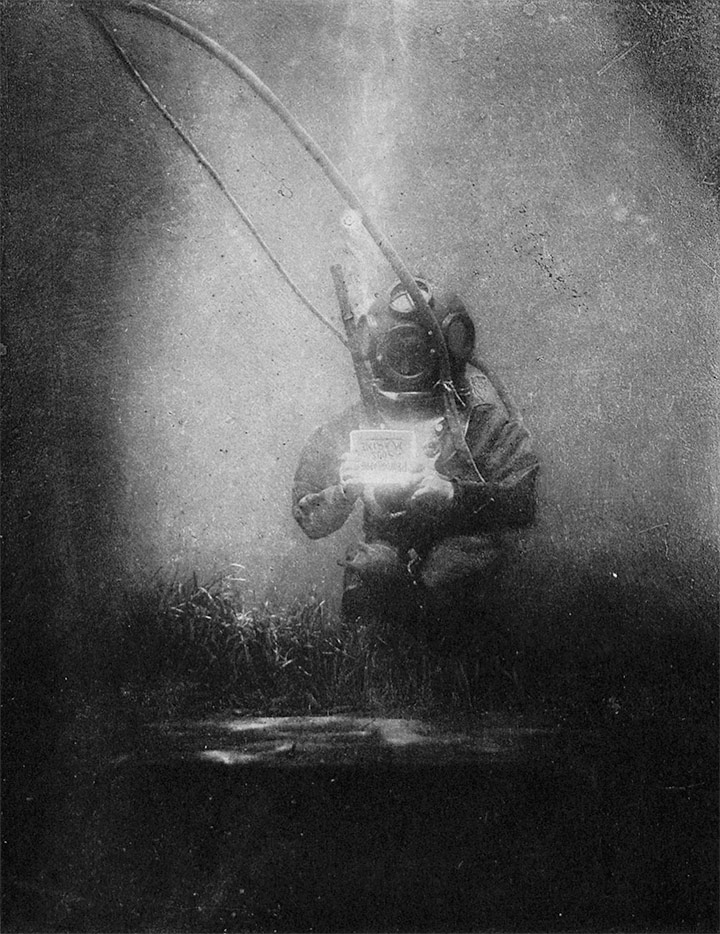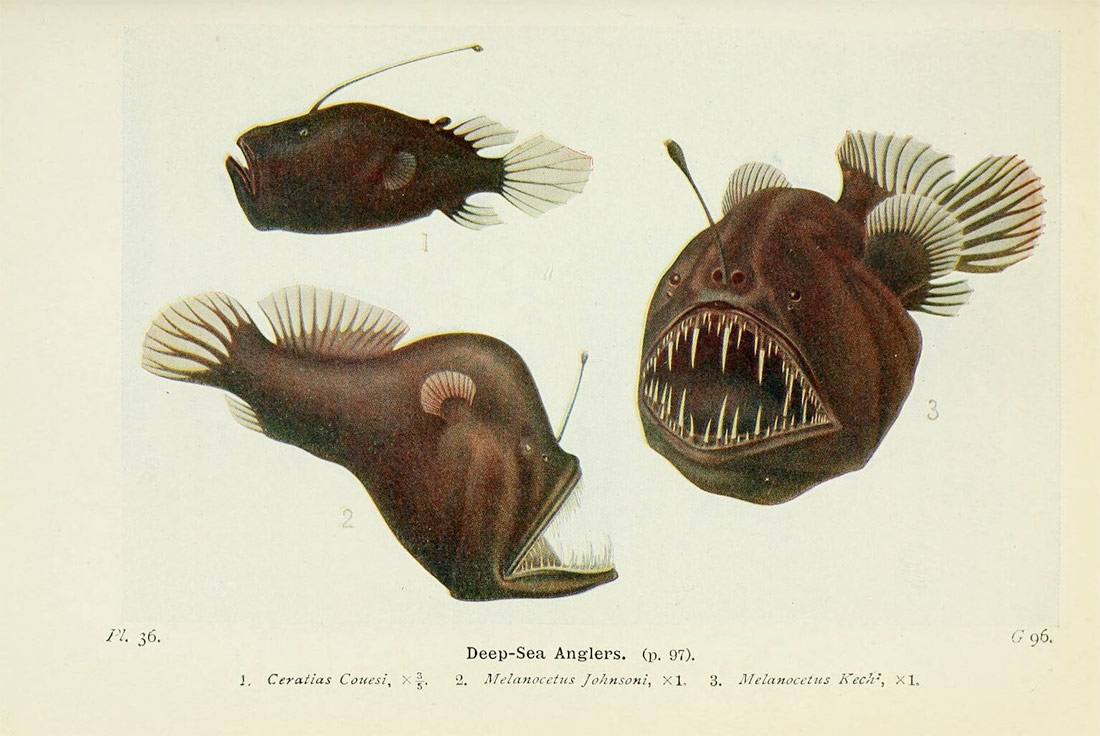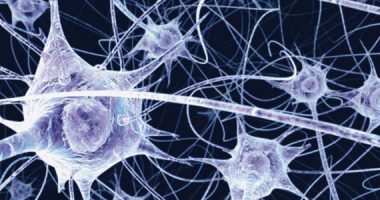
Emil Racovitza as diver at Observatoire océanologique de Banyuls-sur-Mer, 1899 | Louis Boutan, Wikimedia Commons | Public domain
Despite all our scientific advances, even today, well into the 21st century, there are some mysteries that continue to astound us when we look at them straight on. These are the depths that throw into sharp relief our smallness and ignorance of the world which we inhabit. That remind us of our place in the universe and give us a dose of humility.
The word sapiens means “wise” in Latin. Whether this label truly corresponds to humans remains to be determined.
Jeremy Narby. Intelligence in Nature
The ego is a curious mental construction [1] in which the contributions of difference psychological fields converge. It manifests as a mutable concept that each individual shapes according to their own experience in such a way that its restraint or unrestraint forms part of the tense landscape of our coexistence in increasingly complex multicultural societies. Under this mask we call “ego” there exist other regions that are more difficult to manage, as this requires skills that are rarely found in an intensely competitive world addicted to digital hyperconnection and technological acceleration. But wherever we look, prioritising the climate emergency, the challenges speak for themselves – we are immersed in conscious and unconscious “new depths” that are drastically altering our vision of the world, life and the universe. We take a look at some of the main areas of interest, opened up by the exploration of territories for which there are still no definitive maps.
A pale blue dot
On 14 February 1990, some 6 billion kilometres from Earth, the Voyager 1 space probe took a photograph of our planet which, over time, has become an essential touchpoint for the school of humility that we need in all areas of existence. Carl Sagan, the great American scientist and author, attached this photo to a text that conveys like few others our place in the known universe and helps to give that great lesson in humility which all scientific disciplines should include as an essential ethic, as the scientific method itself maintains. Although there are theories that are widely supported by analytical and experimental evidence, and that enjoy a high degree of consensus, no scientific theory can be considered definitive or absolute.
ARVE Error: src mismatch
url: https://www.youtube.com/watch?v=GO5FwsblpT8
src in: https://www.youtube-nocookie.com/embed/GO5FwsblpT8?feature=oembed&enablejsapi=1&origin=https://lab.cccb.org
src gen: https://www.youtube-nocookie.com/embed/GO5FwsblpT8Actual comparison
url: https://www.youtube.com/watch?v=GO5FwsblpT8
src in: https://www.youtube-nocookie.com/embed/GO5FwsblpT8?enablejsapi=1&origin=https%3A%2F%2Flab.cccb.org
src gen: https://www.youtube-nocookie.com/embed/GO5FwsblpT8
And yet, that pale blue dot has been the scene of everything that riotous human history teaches us about limitless ambition, anthropocentric hubris and the misconceptions of our old paradigms. Each step we have taken in our exploration of the sky has given us a dose of humility, a new awareness of the inconceivable magnitude of outer space, with all its countless stars, planets, galaxies, constellations and black holes, as well as dark matter and dark energy. Awareness of all that we do not know, all that we are ignorant of, even though we already know enough to once again reconceive our place in the cosmos.
This new multidimensional depth is very recent. A blink of the eye in terms of “deep time”.[2] The Copernican shift should have worn away our proverbial anthropocentrism and anthropomorphism, and in the third decade of the 21st century there is no excuse left to admit that, as a planet and as a species, we are not the centre of anything, except perhaps our own destiny.
To accept this evidence is not to deny our age-old quest for everlasting wisdom or our need to unravel the great secrets of life and the world. On the contrary, it is the essence of scientific, philosophical and poetic knowledge, as conceived by its best exponents. Recognising that it is fallible guarantees epistemological (and ontological) sanity in the face of the fundamentalisms and fanaticisms that feed the ideologies of hatred, exclusion and war.
The Voyager 1 image also presents us with an immense paradox: on the one hand, it puts us dramatically back in our place within the cosmic scale and reminds us how small we really are. But at the same time, it amplifies our wonder at everything that can be hidden within a speck of dust. The sheer magnitude of the visible universe is set against the great invisible dance of the building blocks of matter revealed to us by quantum physics.
Enigmas of the visible and the invisible, intertwined in a new dimension of depth.
Abyssal worlds
Its body is covered in translucent scales, strangely deformed as if moulded by mysterious forces. Its large yellow eyes glow in the dark. The effect is hypnotic and disturbing. Its mouth is full of sharp, uneven teeth and it has a series of luminous appendages that emit a ghostly, bluish light. It can withstand pressures up to a hundred times greater than that at the surface. With the scientific name of Melanocetus Johnsonii, it is commonly known as the anglerfish or black seadevil. It graced the cover of Time magazine in July 1995 and could easily be mistaken for an alien lifeform.
However, this little “monster” is only one of hundreds of species that inhabit the ocean depths – that vast, largely unknown world that reaches down to a maximum of 10,984 metres in the Mariana Trench. The deep sea is home to giant squid, Jurassic sharks, vampire fish, yeti crabs, mantis shrimps, translucent spiders, elephant octopus and jellyfish of inconceivable beauty, all adapted to extreme conditions of pressure and darkness.

Melanocetus Johnsonii | Open Library | CC BY
Abyssal fauna and flora have been studied for decades in pioneering explorations such as those of Auguste Piccard (1960), whose feats have yet to be surpassed, and the most recent such as Five Deeps (2019), which surveyed the main marine trenches of all five oceans. The expedition had the praiseworthy objective of carrying out a rigorous investigation of the deepest ocean beds, that pitch black zone on which more things depend than we imagine. It is the abyssal ecosystems that support the upward spirals of biodiversity, influencing the ocean currents that play a decisive role in accelerating or mitigating climate change.
The strange call of the abyss fuelled the science and art of the late 20th century, but now we have a huge number of scientific publications, popular science articles, documentaries, podcasts, TV series, works of speculative fiction, comics and Twitter (X) threads conveying all that is being revealed by the ocean depths at a crucial moment for the survival of life on an Earth that could just as easily be called Water.
We can gaze at the fascinating drawings of Ernst Haeckel, one of the forefathers of ecology, or feed our imaginations on the illustrations of artists such as Wayne Barlowe or Ryohei Hase; we can follow the visionary genius of Jules Verne, read Starfish by Peter Watts, or venture into the mysterious Area X created by Jeff VanderMeer. We can also revisit the ominous creatures of H.P. Lovecraft, an essential name on any list of the most disturbing fantasy literature. But perhaps all the efforts made to represent gods or entities such as Cthulhu, Dagon, the Deep Ones or the Elder Things fall short of imagining what lies in the depths of the oceans, of all that dwells on that threshold.
The obsession with the shape of the monsters that inhabit our unconscious is both a reflection of our most hidden fears and a gateway to reinterpreting and reinventing our relationship with Gaia and collective intelligences such as the swarm, the colony and the hive.[3] In Frank Schätzing’s novel The Swarm, the pelagic abyss becomes a great “self-aware” organism that warns humanity of its immense power to end the systematic exploitation and pollution of the oceans. The book also points to the possibility that humility in the face of the unknown may be an empathetic and persevering formula for hope. After all, there is a unanimous consensus that what we know of the deep sea is only a small part of what remains to be known.
The deep unconscious
We create probes that travel beyond the solar system, sophisticated bathyscaphes to explore the deep sea, and we also have the tools to continue to illuminate the darkest parts of our psyche. Interconnected depths, the third of which confronts us with a dimension of our consciousness and unconsciousness that demands particular attention. In this school of psycho-nautical humility, the work of Carl Gustav Jung [4] may act as a powerful beacon.
As is well known, Jung had several disagreements with Sigmund Freud, his mentor and colleague in the study of deep psychology. While Freud thought that psychic energy was primarily focused on sexuality, Jung broadened the concept of libido to also include an erotic force decisive for personal and spiritual growth. This transcendent Eros led him to conceive of a collective unconscious containing universal patterns and symbols shared by all humanity. Our dreams would not only be, as Freud proposed, expressions of repressed desires, but also symbolic messages from the unconscious that reveal the deepest aspects of the psyche, the experience and interpretation of which guides us in the process of individuation, aimed at accepting the intense opposing forces that inhabit us and trying to reconcile them in order to draw a more complete map of the human soul.
It is to the Swiss psychologist that we also owe the idea of synchronicity – significant coincidences that are not causally related but which may be “evidence” of a determining symbolic or psychological meaning. According to Jung, “the unexpected and the incredible belong in this world”. The absurdity or meaning that human life may have depends on an ever-deepening exploration of our uniqueness and our ignorance. Jung’s psycho-nautical humility is a compelling example for continuing to delve into the enigmas of existence – both for glimpsing answers to eternal questions and for wondering at the age-old journey towards the most evolved stages of consciousness. This is a depth closely linked to the depths mentioned above and which should continue to be cultivated if we are to admit, like Jung himself, that we cannot form a definitive opinion as the mysteries of life, the universe and the human phenomenon are still too great.
[1] The word ego (or self) is taken from Latin and is a “cognitive construct” that humanity has elaborated over the centuries and which has resulted in the modern approaches of psychiatry, psychoanalysis and neuroscience. The Wikipedia entry gives an overview (obviously not exhaustive) of all the understandings and debates around the disciplines mentioned.
[2] There are different ways into understanding the concept of “deep time”. This is one of them. It is worth remembering that beginning to understand how we have become a geological force capable of substantially altering the biosphere implies time scales that are difficult for us to relate to. The Anthropocene is precisely that era where we become aware, among other things, of the different timescales of the mineral, plant and animal worlds.
[3] The study of collective intelligences in the animal and plant kingdom has given rise to various approaches and classifications which, in some cases, may have blurred boundaries. They can be classed as hierarchical or centralised collective intelligences, such as the hive, and non-hierarchical collective structures, characterised by collaboration and cooperation among their members, such as schools of fish, flocks of birds, colonies of bacteria or forests and jungles. It is clear that what we learn from these systems can influence the way in which we organise ourselves socially and politically.
[4] Carl Gustav Jung (1875-61) is one of the great investigators of human consciousness and imagination. His vast output, including works published posthumously such as The Red Book (2009), is an extraordinary exploration of the human psyche that can be complemented by the account of his life that Jung set down at the age of eighty-one with the help of his colleague and friend Aniela Jaffé. See Carl Gustav Jung, Memories, Dreams, Reflections.





Leave a comment